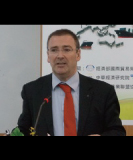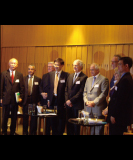You are browsing > Service in Taiwan > Development
WTO members consider six regional trade agreementsWTO
WTO members considered six regional trade agreements (RTAs) involving countries and trading blocs from across the world at a meeting of the Committee on RTAs on 18 November.
Economic Partnership Agreement between EU and Cameroon
The Economic Partnership Agreement between the European Union and Cameroon, applied provisionally since 2014, provides for reciprocal liberalization of trade in goods. All but 18 of the EU's tariff lines are now bound at zero for Cameroon's exports and Cameroon will liberalize about 77 per cent of its tariff lines by 2029. The Agreement also includes provisions on competition and e-commerce and provides for future gradual, reciprocal and asymmetrical services liberalization.
The EU stressed that it remains Cameroon's main trading partner, accounting for 47 per cent of Cameroon's global exports and 28 per cent of its imports in 2019. Cameroon's main exports to the EU consist of oil, cocoa beans and bananas and its main imports include machineries, medication, clothes, refined oils, cement clinkers and cars. In 2019, total trade between the EU and Cameroon accounted for almost USD 3.5 billion.
Through this Agreement, Cameroon aims to diversify exports and attract further foreign direct investment. Other objectives include infrastructural and rural development, food security, industrial diversification, regional integration and business environment improvement. Cameroon also noted that its banana growers registered EUR 48 million worth of support from the EU over the period 2015-2020.
Economic Partnership Agreement between the EU and the SADC States (Botswana, Eswatini, Lesotho, Mozambique, Namibia and South Africa)
Under the Economic Partnership Agreement between the European Union and the Southern African Development Community (SADC) States (Botswana, Eswatini, Lesotho, Mozambique, Namibia and South Africa), all but 1.3 per cent of the EU's tariffs will be liberalized for imports from all SADC States except for imports from South Africa for which all but 4.3 per cent of the EU's tariffs will be liberalized. Liberalization by the SADC States will take place in stages until 2028, at which time 13.9 per cent of the tariff lines of the Southern African Customs Union (Botswana, Eswatini, Lesotho, Namibia and South Africa) and 44.5 per cent of Mozambique's tariff lines will remain subject to duties.
The EU said that it is the SADC States' main trading partner, accounting for 20 per cent of their exports and 22 per cent of their imports in 2019. Also in 2019, the EU's exports to SADC amounted to EUR 24.6 billion while its imports were worth EUR 23.1 billion. The SADC States' exports to the EU have increased by 19 per cent over the period 2015-2019. The trade flows essentially concern industrial products. The SADC States mainly import car parts from the EU and mainly export cars and other vehicles to the EU.
Botswana, on behalf of the SADC States, noted that the Agreement aims to strengthen the States' regional integration and participation in regional value chains and to support the achievement of their development objectives. While preferential market access is provided by both parties, the SADC States may protect some sensitive sectors through safeguard measures. A bilateral protocol on trade in wine and spirits and on the protection of geographical indications of wine, spirits, beer and some agricultural products is also in place between South Africa and the EU. Other objectives include harmonising customs legislation and procedures and exchanging information on sanitary and phytosanitary measures in agriculture, including food security.
Comprehensive Economic Partnership Agreement between India and Korea
Under the Comprehensive Economic Partnership Agreement between India and Korea, India liberalized 69.5 per cent of its tariffs and Korea 88.6 per cent. Rates were also reduced on around 13.9 per cent of India's tariffs and 4.4 per cent of Korea's tariffs. The Agreement's other provisions include sanitary and phytosanitary measures and technical barriers to trade, safeguards, dispute settlement and customs cooperation.
India said that the Agreement provides for a mutual expansion of job opportunities for computer specialists, engineers, managing consultants and assistant English teachers. Trade between both parties had increased by 70 per cent in ten years, from USD 12 billion in 2009 to USD 21.3 billion in 2018. India's imports from Korea almost doubled from around USD 8 billion in 2009-2010 to USD 16 billion in 2018-2019 although exports to Korea had increased marginally, thus resulting in an increasing trade imbalance.
Korea said that the Agreement goes beyond each party's WTO commitments in many areas. Investment flows between both countries have also grown by 124 per cent over the period 2009-2019, from USD 349 million to USD 782 million. The parties are currently negotiating to add to the Agreement provisions on goods, services and investment, with the objective of maximizing benefits for both countries.
Free Trade Agreement between EFTA and the Philippines
Immediate tariff liberalization is foreseen by the European Free Trade Association (EFTA) Stateson goods and services, with some limitations for some agricultural products. By the end of the nine-year transitional period, the Philippines will have progressively eliminated tariffs on almost 90 per cent of its imports from EFTA States.
The Philippines said that the Agreement is progressive in terms of scope and coverage and ranges from investment to intellectual property rights, trade in goods and government procurement. Total trade between both parties increased by 2.4 per cent between 2018 and 2019, from USD 802 million to USD 821 million. The Philippines' exports to EFTA grew by 17 per cent between 2018 and 2019, from USD 370 million to USD 434 million.
On behalf of EFTA, Switzerland noted an increase in bilateral trade, with the Philippines' exports to EFTA up from USD 250 million in 2017 to over USD 300 million in 2019. By providing stable and predictable trading conditions, the Agreement provides a significant potential to further boost trade between the two traders.
Free Trade Agreement between Australia and Hong Kong, China
Bilateral trade in goods between Hong Kong, China and Australia is entirely duty free since the entry into force of the Free Trade Agreement in January 2020. Notable market access improvements have also been made by the parties on trade in services, and regulatory cooperation has been strengthened.
Australia said that Hong Kong, China was its 11th largest export market and 15th largest two-way trading partner in 2019. It was also the fifth largest investor in Australia and tenth largest destination for Australian investment overseas. Australia stressed the high quality of the Agreement, which promotes growth in goods and services trade while also addressing non-tariff barriers and ensuring efficient customs settings, particularly for food and beverages.
Hong Kong, China pointed to improved business opportunities and legal certainty for its traders and investors as a result of the Agreement, in addition to simplified customs procedures and enhanced customs cooperation, among other things.
Comprehensive Economic Partnership Agreement between Chile and Indonesia
The Comprehensive Economic Partnership Agreement between Chile and Indonesia is Indonesia's first free trade agreement with a Latin American country. The Agreement essentially contains provisions on trade in goods and includes a clause for the future incorporation of chapters on trade in services and investment.
Chile said that Indonesia eliminated duties on approximately 55 per cent of its tariff lines and provides for progressive duty-free access to 86 per cent of its tariff lines for Chilean traders. Chile will progressively grant duty-free access to Indonesia on 89.6 per cent of its tariff lines.
Some of the Chilean goods that enjoy duty-free access to Indonesia are: butter, almonds, hazelnuts, fresh fruits such as avocados, oranges, and lemons, honey, grape and apple juice. Indonesia said that it is benefiting from a preferential tariff on its exports of products ranging from footwear, motor vehicles and machinery to textiles, detergent and perfume. Between January and September 2020, the total trade between the two countries accounted for approximately USD 180 million. It is projected to increase by 33 per cent from the date of entry into force in 2019 within the next three years.
RTAs and transparency
In accordance with the Transparency Mechanism for RTAs, the Chair of the Committee, Ambassador Mārtiņš Kreitus of Latvia, informed members that 36 early announcements of RTAs had been made and were available on the WTO's webpage. Members' notifications can be found here.
Three notifications were submitted since the last meeting in September: the entry into force of the Agreement between the United States, Mexico and Canada (goods and services); the notification of termination of the North American Free Trade Agreement (NAFTA) (goods and services); and the accessions of Samoa and the Solomon Islands to the Interim Partnership Agreement between the EU and the Pacific States (goods).
Two notifications of changes were received on the services aspects of two agreements between China and respectively Macao, China and Hong Kong, China. The Chair reported that 53 RTAs have still not been notified to the WTO.
The Chair also noted that factual presentations had to be prepared for 21 RTAs involving WTO members only and a further 23 involving non-members, counting goods and services separately. The Chair said he had held consultations with delegations for which the consideration of RTAs remains delayed due to the lack of comments or data from the members involved.









